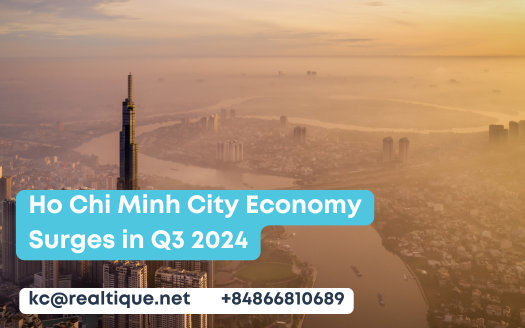Ho Chi Minh City Economy Surges in Q3 2024
Ho Chi Minh City’s economy experienced notable growth in Q3 2024, largely propelled by a thriving services sector that achieved an extraordinary 7.46% increase. This growth not only enhanced the city’s overall gross regional domestic product (GRDP) but also indicated a strong consumer demand reflected in a 10.6% rise in retail sales and service revenue. However, the performance of other sectors, particularly manufacturing and agriculture, raises questions about the sustainability of this upward path. What implications might these contrasting sector performances have for the city’s future economic environment?
Table of Contents
HCMC Economic Growth Overview
Ho Chi Minh City has demonstrated notable economic resilience, showcasing a strong economic growth rate of 7.33% in the third quarter of 2024.
This growth path builds upon the earlier quarters, where the city’s Gross Regional Domestic Product (GRDP) recorded 6.54% and 6.31% in Q1 and Q2, respectively.
Despite being slightly below the national GDP growth of 7.4% for the same period, the cumulative growth of 6.85% for the first nine months of 2024 reflects a positive trend compared to the previous year.
The economy is primarily driven by advancements in key sectors, setting a promising foundation for continued development.
Consequently, maintaining this momentum will be essential for achieving future economic targets and overall stability in the region.
HCMC Key Sector Contributions
In the context of Ho Chi Minh City’s economic environment, key sector contributions have played an essential role in driving growth.
The industrial and construction sectors experienced a 6.62% increase, contributing 22.2% to the city’s Gross Regional Domestic Product (GRDP).
The services sector outpaced others with a growth rate of 7.46%, accounting for nearly 70% of overall GRDP growth, demonstrating its vital role in the economy.
Despite these gains, the agriculture sector faced challenges, contributing only 0.5% to the GRDP.
Additionally, the manufacturing index recorded a year-on-year increase of 6.9%, while construction growth was limited to 5.29%, reflecting ongoing issues in capital allocation.
Investment and Capital Disbursement
Significant challenges in investment and capital disbursement have emerged as key factors influencing Ho Chi Minh City’s economic performance. As of September 27, over 15,800 billion VND was disbursed from the state budget, comprising only 19.9% of the planned capital for 2024. This shortfall necessitates a 9.5% growth in Q4 to meet the annual target of 7.5%. The urgent focus on capital allocation for public projects remains critical to strengthen economic stability.
| Indicator | Value |
|---|---|
| Total Capital Disbursed | 15,800 billion VND |
| Percentage of Planned Capital | 19.9% |
| Required Q4 Growth | 9.5% |
| Annual Target | 7.5% |
| Public Projects Focus | Urgent |
Trade and Services Performance
Experiencing strong growth, the trade and services sector in Ho Chi Minh City demonstrated a notable increase in retail sales and service revenue, which surged by 10.6% in Q3 2024.
Cumulatively, retail sales for the first nine months reached over 872,300 billion VND, reflecting a 10.5% rise compared to the previous year.
The wholesale and retail trade sectors showed significant improvement, contributing to the overall economic stability of the city.
This vigorous performance highlights the resilience of the service sector amidst challenges in other areas.
Additionally, traditional trade channels are anticipated to continue their upward path, projecting sustained growth through Q1 2025, enhancing the city’s economic environment and consumer confidence moving forward.
Challenges and Future Outlook
While the trade and services sector has shown exceptional resilience, the broader economic growth of Ho Chi Minh City confronts several challenges. Slow capital disbursement and unfavorable external market conditions hinder progress. The manufacturing sector has stagnated, with 9 out of 30 industries reporting declines. Additionally, rising labor costs are affecting production expenses, while tax revenue shortfalls in the retail sector demand strategic solutions. A continued focus on improving the business environment and attracting investment is essential for sustained growth.
| Challenge | Impact |
|---|---|
| Slow capital disbursement | Limited public project execution |
| Manufacturing stagnation | Decline in industrial productivity |
| Rising labor costs | Increased production expenses |
| Tax revenue shortfalls | Budget constraints for essential services |





